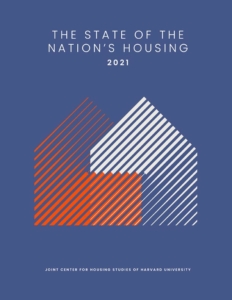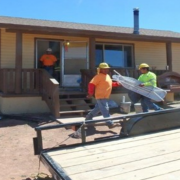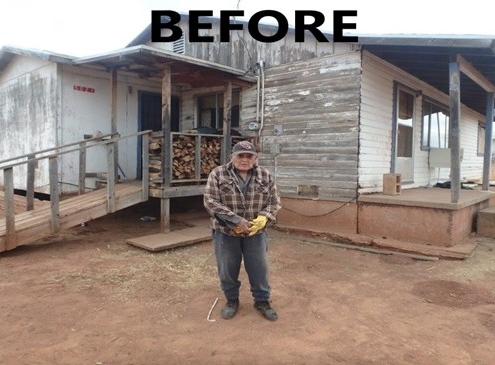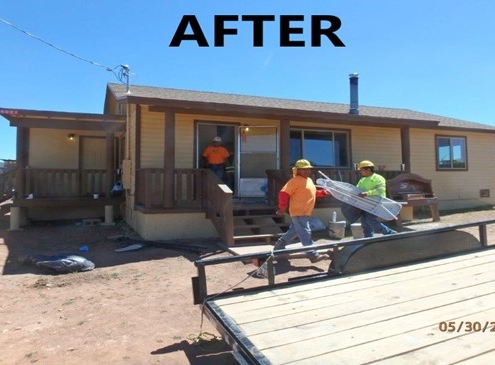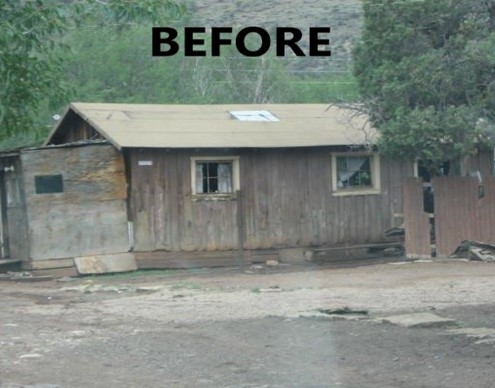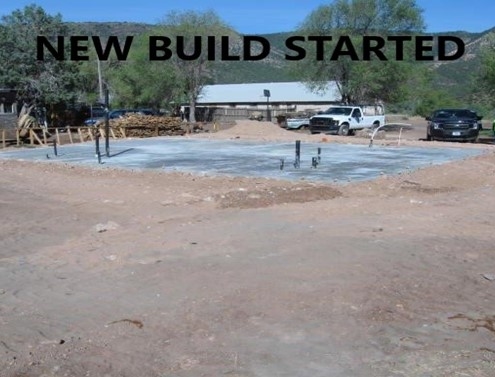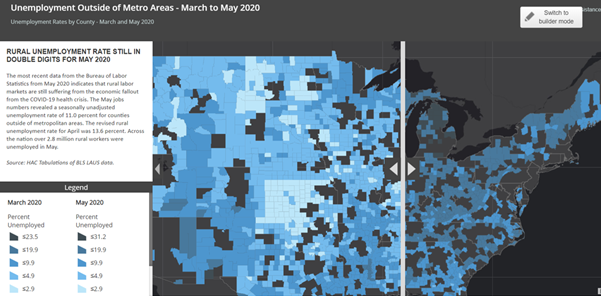Hurricane Laura made landfall near Cameron, Louisiana, as a Category 4 storm in early morning n August 27, 2020. HAC offers the following guide as a source of information for individuals and families dealing with direct housing loss and damage from the storm. For more information, please see HAC’s report: Picking up the Pieces: Restoring Rural Housing and Communities After a Disaster and Disaster Response for Rural Communities Guide.
If your house is inaccessible or currently uninhabitable, emergency, transient housing will likely be made available to provide immediate shelter for those in need. Organizations and resources available to assist with emergency transient housing in previous similar disasters include the Red Cross, Salvation Army, Church World Service, Mennonite Disaster Service, and state- and city-run emergency shelters aimed at housing victims of Hurricane. If you are in need of emergency, transient housing, you can text SHELTER and your Zip Code to 43362 (4FEMA) to find where the shelter closest to you is located.
FEMA makes available temporary assistance funding available for residents of counties affected by hurricanes. Temporary assistance can include grants for temporary housing and home repairs, low-cost loans to cover uninsured property losses, and other programs to help individuals and business owners recover from the effects of the disaster. To see if you are eligible for funding, you can apply online at https://www.disasterassistance.gov/ or call FEMA’s toll-free helpline at 1-800-621-FEMA(3362). When applying, make sure to have a pen and paper as well as the following information: your social security number, current and pre-disaster address, a telephone number where you can be contacted, insurance information, total household income, a routing and account number from your bank if you are interested in having disaster assistance funds transferred directly into your bank account, and a description of your losses that were caused by the disaster.
Tips
Please keep in mind the following safety protocols for hurricanes and flooding:
- Only call 911 if you have an immediate need for medical attention or evacuation assistance.
- If you can’t get through to 911 on first try, keep calling.
- DO NOT DRIVE through high water and DO NOT DRIVE AROUND BARRICADES! Just 2 feet of water can sweep your vehicle away.
- DO NOT WALK through flood waters. Just 6 inches of moving water can knock you down. 4
- If your home floods, STAY THERE. You are safer at home than trying to navigate flooded streets on foot.
- If floodwaters rise around your car but the water is NOT MOVING, abandon the car and move to higher ground. Do not leave the car and enter MOVING water.
- STAY AWAY from streams, rivers, and creeks during heavy rainfall. These areas can flood quickly and with little warning.
- MOVE important items – especially important documents like insurance policies – to the highest possible floor. This will help protect them from flood damage.
- DISCONNECT electrical appliances and do not touch electrical equipment if you are wet or standing in water. You could be electrocuted.
This flooding event is a reminder that all residents in this area should carry flood insurance. Contact your insurance agent for more information about purchasing flood insurance or visit the National Flood Insurance Program at www.fema.gov/national-flood-insurance-program or call 1-888-379-9531. Please keep in mind that new insurance policies take 30 days to go into effect.
If your home has experienced damage, remember to check the outside of your home before you enter. Look for loose power lines, broken or damaged gas lines, foundations cracks, missing support beams, or other damage. It may be safest to ask a building inspector of contractor to check the structure before you enter. Do not force jammed doors open, as they may be providing needed support to the rest of the home. Sniff for gas to ensure there are no natural or propane gas leaks. If you do have a propane tank system, make sure to turn off all valves and contact a propane supplier to check the system before you use it again. Check floors and ceilings to ensure they are not sagging from water damage. This can be especially hazardous. Take photographs of any damage as you may need them for insurance claims or FEMA claims later on.
Resources
Apply for FEMA Assistance by registering online at www.DisasterAssistance.gov. FEMA Disaster Assistance Helpline answers questions about the help offered by FEMA, how to apply for assistance, or the information in your account.
Toll-free helpline: 1-800-621-FEMA (3362)
For hearing impaired callers only:
1-800-462-7585 (TTY)
1-800-621-3362 (Video Relay Service)
Operators are multilingual and calls are answered seven days a week from 7 a.m. to 11 p.m. ET
American Red Cross Disaster Service: For referrals and updates on Red Cross shelter services in your area, locate a local Red Cross office through: https://www.redcross.org/find-help or by calling 1-800-RED CROSS (1-800-733-2767)
The Red Cross helps disaster victims by providing safe shelter, hot meals, essential relief supplies, emotional support and health services like first aid. Trained Red Cross workers often meet one-on-one with families to develop individual plans and identify available resources to help aid recovery.
STATE HOUSING AGENCIES
Arkansas
Arkansas Development Finance Authority
P.O. Box 8023
Little Rock, AR 72203-8023
Phone: (501) 682-5900
Fax: (501) 682-5939
https://www.arkansas.gov/adfa
Louisiana
Louisiana Housing Corporation
2415 Quail Drive
Baton Rouge, LA 70808
Phone: (225) 763-8700
Fax: (225) 763-8710
https://www.lhc.la.gov
Mississippi
Mississippi Home Corporation
735 Riverside Drive
Jackson, MS 39202-1166
Phone: (601) 718-4642
Fax: (601) 718-4643
https://www.mshomecorp.com
Missouri
Missouri Housing Development Commission
920 Main Street, Suite 1400
Kansas City, MO 64105-2017
Phone: (816) 759-6600
Fax: (816) 759-6638
https://www.mhdc.com
Oklahoma
Oklahoma Housing Finance Agency
100 NW 63rd Street, Suite 200
Oklahoma City, OK 73116-8250
Phone: (405) 848-1144
Fax: (405) 419-9211
https://www.ohfa.org
Tennessee
Tennessee Housing Development Agency
502 Deaderick Street, Third Floor
Nashville, TN 37243
Phone: (615) 815-2200
Fax: (615) 564-2700
https://www.thda.org
Texas
Texas Department of Housing and Community Affairs
221 E 11th Street
Austin, TX 78701-2410
Phone: (512) 475-3800
Fax: (512) 469-9606
https://www.tdhca.state.tx.us
DEPARTMENT OF HOUSING AND URBAN DEVELOPMENT STATE FIELD OFFICES
Arkansas
Little Rock Field Office
425 West Capitol Avenue
Suite 1000
Little Rock, AR 72201-3488
Phone: (501) 918-5700
Director: Wanda C. Merritt
Louisiana
Hale Boggs Federal Building
500 Poydras Street
9th Floor
New Orleans, LA 70130
Phone: (504) 671-3001
Director: Bam Gressett
Mississippi
Dr. A. H. McCoy Federal Building
100 West Capitol Street
Room 910
Jackson, MS 39269-1096
Phone: (601) 965-4757
Director: Jerrie G. Magruder
Missouri
St. Louis Field Office
1222 Spruce Street
Suite 3.203
St. Louis, MO 63103-2836
Phone: (314) 418-5400
Director: James Heard
Oklahoma
Tulsa Field Office
110 West 7th Street
Suite 1110
Tulsa, OK 74119
Phone: (918) 292-8900
Director: Sharon Gordon-Ribeiro
Tennessee
John J. Duncan Federal Building
710 Locust Street, SW 3rd Floor
Knoxville, TN 37902-2526
Phone: (865) 545-4370
Memphis Field Office
200 Jefferson Avenue
Suite 300
Memphis, TN 38103-2389
Phone: (615) 515-8510
Director: Sernorma L. Mitchell
Texas
Houston Field Office
1301 Fannin Street
Suite 2200
Houston, TX 77002
Phone: (713) 718-3199
Director: Edward L. Pringle
USDA RURAL DEVELOPMENT STATE OFFICES
Arkansas
David Branscum, State Director
Federal Building
700 West Capitol Avenue, Room 3416
Little Rock, AR 72201-3225
Voice: (501) 301-3200
Fax: (855) 747-7793
www.rd.usda.gov/ar
Louisiana
Roy Holleman, State Director
3727 Government Street
Alexandria, LA 71302
Voice: (318) 473-7920
Fax: (844) 325-6949
www.rd.usda.gov/la
Mississippi
John G. Campbell, State Director
Federal Building, Suite 831
100 West Capitol Street
Jackson, MS 39269
Voice: (601) 965-4316
Fax: (601) 965-4088
www.rd.usda.gov/ms
Missouri
Jeff Case, State Director
601 Business Loop 70 West
Parkade Center, Suite 235
Columbia, MO 65203
Voice: (573) 876-0976
Fax: (855) 830-0684
www.rd.usda.gov/mo
Oklahoma
Lee Denney, State Director
100 USDA, Suite 108
Stillwater, OK 74074-2654
Voice: (405) 742-1000
Fax: (405) 742-1005
www.rd.usda.gov/ok
Tennessee
Jim Tracy, State Director
441 Donelson Pike, Suite 310
Nashville, TN 37214
Voice: (615) 783-1300
Fax: (855) 776-7057
www.rd.usda.gov/tn
Texas
Edd Hargett, State Director
Federal Building, Suite 102
101 South Main Temple, TX 76501
Voice: (254) 742-9700
Fax: (844) 496-8123
www.rd.usda.gov/tx
STATE EMERGENCY MANAGEMENT AGENCIES
Region 4 (Mississippi and Tennessee)
Federal Emergency Management Agency
3003 Chamblee Tucker Road
Atlanta, GA 30341
Main Number: 770-220-5200
Fax Number: 770-220-5230
Region 6 (Louisiana, Arkansas, Oklahoma, and Texas)
Federal Emergency Management Agency
FRC 800 North Loop 288
Denton, TX 76209-3698
Regional Office Main Number: 940-898-5399
Louisiana Recovery Office Main Number: 225-242-6000
Region 7 (Missouri)
Federal Emergency Agency
221 Ward Parkway
Kansas City, MO 64114
Main Number: 816-283-7061

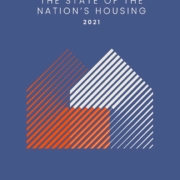 Harvard Joint Center for Housing Studies
Harvard Joint Center for Housing Studies